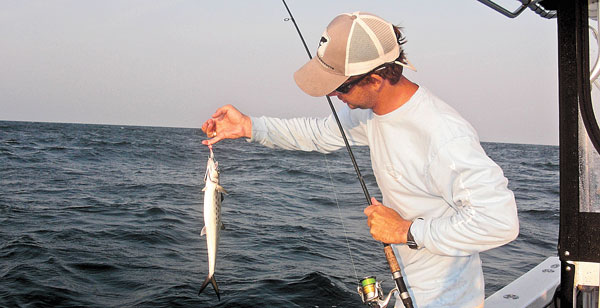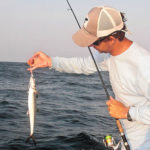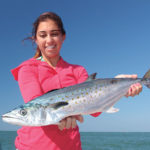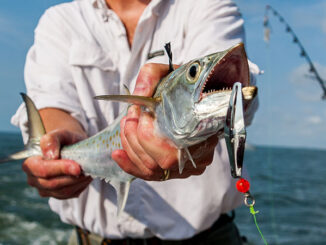
The seafood special of the month has to be the forked-tailed Spanish mackerel armada that infiltrates both the nearshore and inshore waters. They have a range of voracity that can vary from aggressive to finicky, which can keep anglers guessing — but a sustained effort will usually win out. Fly rods are perfect for these smaller fish, but light spinning tackle is required when trolling.
Capt. Graham Hegamyer of Southern Tail Charters in Charleston prefers an 8-weight fly rod outfit when fishing for Spanish mackerel and stresses spooling up with a weight-forward floating fly line.
“The gummy fly works great and is almost an exact match for the glass minnows that the Spanish love,” said Hegamyer. “But a simple white Clouser minnow, or most anything with some bucktail, will also work.
“The retrieve I use is to wait three seconds for the fly to settle just under the water’s surface, and then strip it just as fast as you can,” Hegamyer said.
When the Spanish are aggressive, a fisherman realizes that there is no chance at retrieving the fly too fast. Those Spanish are fast because they are slashing-type feeders, and when they hit the fly, one feels a solid jolt from the slender fish with the distinctive yellow spots.
“Getting on the Spanish is great fishing because everyone in the boat is seeing the fish, making casts and feeling involved in the action,” Hegamyer said.
While Spanish can be found in rip currents around structure, inshore waters are the best places to target them. Hegamyer said to look for a tideline of some kind, the boundary where the outgoing tide from the inshore meets the ocean waters, often producing a color change. The inshore water will appear brownish, and the ocean water a clear blue or clear green — sometimes known as “king green.” Be knowledgeable about the local tides, because the harder the tide ebbs, the further out the tideline will be found.
“Look for birds that are diving, and if you see several groups, then pick out the largest group of diving birds,” Hegamyer said. “I don’t really look for bait at this point; I’m looking for Spanish that are breaking the surface. When the water gets fishy, then the birds get aggressive and fly down at top speed.”
Don’t forget that bluefish and king mackerel can also crash this party.
Hegamyer has a philosophy that’s worth noting.
“I look for happy fish rather than the closest school of Spanish,” he said, explaining that he would rather circle the boat for a few extra minutes to diagnose which school stays up the longest and is feeding heartily.
“That way, when we cast to them, it doesn’t really matter how great the cast is or what lure is being used, because they are going to whack it!”
When watching birds over the water, remember that they can see the Spanish mackerel coming from underneath the baitfish to attack because they see the flash of their silver sides. Plus, the birds have about 100 sets of eyes in the sky, and only one of them has to glimpse the imminent charge of the Spanish, because the other birds can react and turn on a dime to join the frothy feeding frenzy.
Another interesting point is that when Spanish sound, the birds break off their bombing runs and immediately switch back into lazy mode.
“The birds don’t waste their time making extra dives when the school sounds, and neither should anglers,” Hegamyer said.
Spanish are up and down, up and down — and always on their own schedule — so it’s best for the anglers to get poised and ready to make a quick cast when they pop up again. Perhaps taking a minute to give thanks for the natural resources that allow for such recreational fishing activities.
Some of the best-known lures to catch Spanish mackerel are Clark Spoons and Got-Cha plugs. While the Got-Cha comes with treble hooks and a variety of colors, the single-hook Clark Spoons are either silver or gold. The No. 00 Clark Spoon is a fine match for a small bait and is perfect for trolling, but it does not cast far. A weighted Clark Caster spoon (CC No. 18) might be a good one to keep in the tackle box for casting scenarios.
While these tried-and-true tackle shop gems will likely draw the most strikes from hungry Spanish macks, don’t forget that when they are in a frenzy some other improvised baits might also work.
Anyone remember the McDonald’s straw lure, which has white, with red and yellow stripes? Cut a third of the straw and then add a hook and troll for effect.
Another special rig is to take a leadhead jig and tie white feathering to it. No doubt there are other lure variations that can be deadly on schooled up Spanish too, lures that anglers appreciate for being a bit more economical.






Be the first to comment